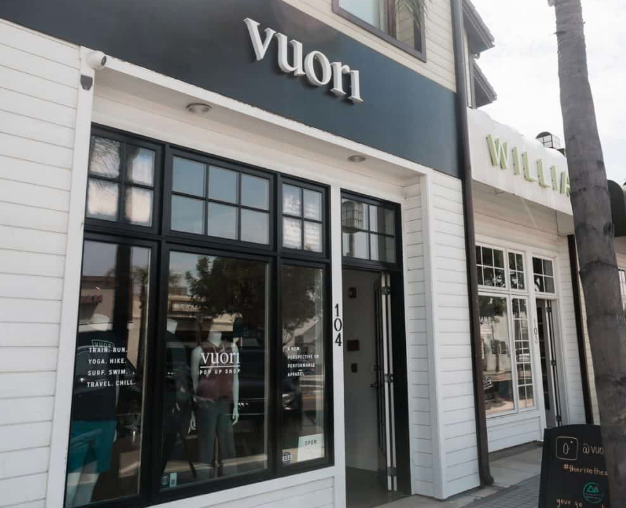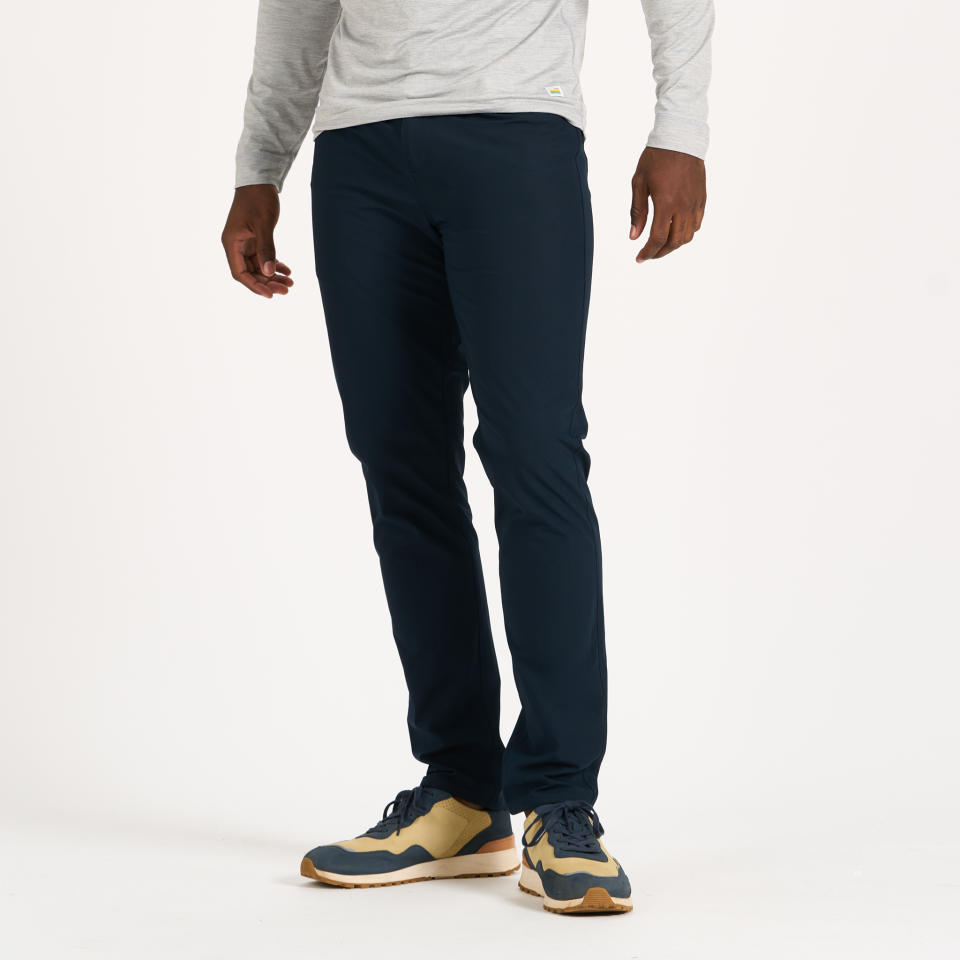Vuori Sets Aggressive Expansion After $400M Investment

When Jim Gold, the former chief of Neiman Marcus, predicted two years ago that Vuori could be a $1 billion brand, a lot of eyes rolled.
Not anymore.
More from WWD
On Wednesday, the Encinitas, Calif.-based activewear and sportswear brand that Gold invested in some two years ago received a $400 million investment from SoftBank Vision Fund 2 for a minority stake, bringing Vuori’s valuation to $4 billion. The investment is one of the largest in recent memory for an independent fashion brand. Up until now, Vuori’s largest investor was Norwest Venture Partners, which wrote a check for $45 million to the company in the summer of 2019 for a minority stake.
“From the garage to $4 billion — I never saw it coming and feel very grateful,” said Joe Kudla, Vuori’s chief executive officer who founded the brand in 2015. “It’s a big milestone for us. SoftBank has a long track record of identifying market-leading companies and supporting entrepreneurs with bold visions. We are grateful to have their partnership as we move into an exciting new period of growth and evolution as a company.”
Kudla, a former accountant, created Vuori in 2015 to fill a void he saw in the men’s activewear market for workout shorts that could take a man from the gym to lunch. He raised $300,000 from friends and family and created moisture-wicking, quick-drying shorts with a distinctly coastal California aesthetic. He named the brand after the Finnish word for mountain to represent the clarity one gets after a trip to the summit.
The success of the shorts allowed Vuori to expand into more products such as joggers, sweats, Ts, chinos and accessories, all produced under its ethos of “Designed to move and sweat in, but styled for everyday life.” It launched women’s wear in 2018 and now offers sportswear basics, outerwear, swimwear and a travel collection, all with the same ethos.
Kudla said Wednesday the company will use the funds to expand its product offering, move into international markets, significantly increase its brick-and-mortar presence, make further investments in infrastructure and staff and expand its sustainability efforts. Currently, and through partnerships with organizations such as Climate Neutral and Cleanhub, Vuori is offsetting its carbon and plastic footprints while taking steps to eliminate 80 percent of plastics from its shipping and supply chain by 2022.
Kudla said that next spring Vuori will launch in the U.K with an e-commerce site as well as through wholesale partners including Selfridges, Harrods and Cotswold, a British retailer he likened to the U.K. version of REI.
“And we will open our first store in the spring in London,” he said. “That’ll be our first entrance into Europe.”
Beyond that, Kudla said building out Western Europe — France, Germany and Italy — is in the plan as well, starting with an online presence.
Asia Pacific is also in Kudla’s sights. “Later in 2022, we’re going to launch in China and Japan,” he said.
Initially, the plan is to operate directly in that region with partners such as Tmall before moving into brick-and-mortar stores in 2023. The company will also open an innovation center in Taiwan.
In 2023, he hopes to bring Vuori to the Middle East, Australia and New Zealand as well.
Closer to home, the Vuori retail rollout in the States will also be pushed into overdrive. The brand currently operates nine stores in the U.S., a number that will rise to 14 by the end of the year. “Our goal is to get to 100 by 2026,” he said.
While that sounds aggressive, Vuori said operating 100 stores is “still a fraction of what larger brands like Lululemon have.” At the beginning of this year, Lululemon operated a little over 300 stores.

Courtesy of vuoriclothing.com
Visiting brick-and-mortar stores is the best way for Vuori’s current and potential customers to experience the brand, Kudla believes. “Our customers love to feel the product and it’s important to us to make that connection.”
He said that since opening the first Vuori pop-up in 2015, the retail stores have helped enhance the e-commerce site. “We love what the stores bring,” he said, adding that they also allow the company to host community events and “bring people together.”
But Kudla stressed that this focus on direct-to-consumer is not expected to impact Vuori’s wholesale business with Nordstrom, REI and others. “Our wholesale strategy is very strategic,” he said. “We’re not over-distributed and our current wholesale performance is complementary to this strategy.”
Turning to product, Kudla said women’s wear has now grown to represent 50 percent of Vuori’s overall business and “is growing very fast. Our assortment size is now as large as the men’s,” he said.
Even so, he has no intention of letting the women’s wear dominate the assortment in the future. “Our goal is to still have it be 50-50,” he said.

Top performers include performance loungewear, which saw a sharp increase in interest during the height of the pandemic and has not yet dipped substantially, along with its commuter offering.
“Our travel assortment features technical fabrics and construction applied to everyday sportswear,” Kudla explained. “And that’s doing very well for both men and women.”
He said expanding outerwear, which speaks to the increased interest in the outdoors space, as well as swimwear is in the cards.
Vuori is certainly not alone in its quest to capture market share in the performance apparel space. Others brands including Rhone, Fourlaps and Mack Weldon — as well as Lululemon — have also gained a foothold and managed to carve out a niche from the behemoths such as Nike, Adidas and Under Armour by focusing more on lifestyle offerings with performance attributes.
Kudla believes what sets Vuori apart is not only its soft hand but also its design sensibility, which ticks a lot of boxes.
“Our customers love our sensibility from a tactile standpoint,” he said. “And our product is rooted in versatility. That might seem commonplace today, but Vuori was one of the first to do it. We stripped down all the unnecessary bells and whistles that made it look like the guy just left the gym and made product that was ultra-wearable.”
With the pandemic creating demand for product that looks good and performs, it opened the door even further, he said, for the customer seeking clothing that is appropriate for a variety of uses and is also comfortable.
In addition, he said that while “most activewear is inspired by urban street culture or street sports, Vuori draws its influence from the beach. We were the first to bring that aesthetic into activewear.”
He said at first, potential retail partners were resistant to that idea, forcing Vuori to build a strong direct-to-consumer business. “But now, we’re one of the best performers in wholesale because of our different take on the category of traditional activewear,” Kudla said.
SoftBank obviously agrees.
“With its strong consumer engagement, sustainability focus and sheer growth, we believe Vuori is a leading brand in the attractive activewear market,” said Nagraj Kashyap, managing partner at SoftBank Investment Advisers. “We are delighted to partner with Joe and the Vuori team as they introduce new products to consumers and expand globally.”
Kudla, a California native, athlete and one-time model, was a senior auditor with Ernst & Young before founding Vaco, a professional staffing company that was among San Diego’s fastest-growing companies during his tenure. He sold that business and was searching for something else to do when chronic back pain that he’d sustained after years of football and lacrosse led him to yoga, which eventually led to the creation of Vuori.
Sign up for WWD's Newsletter. For the latest news, follow us on Twitter, Facebook, and Instagram.

